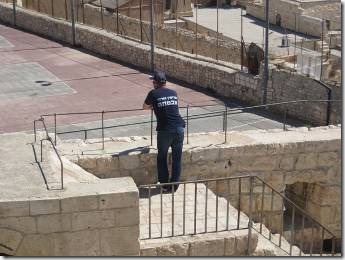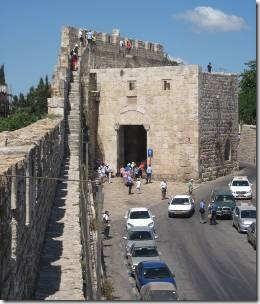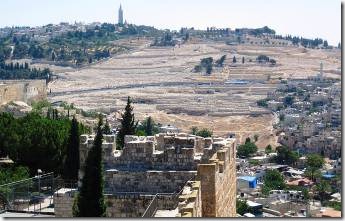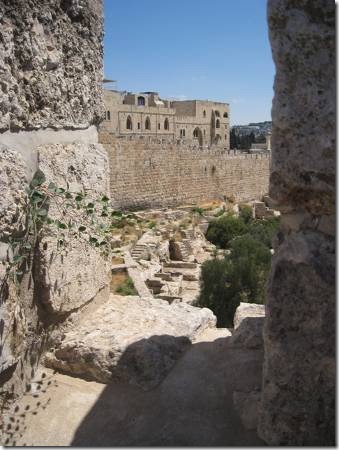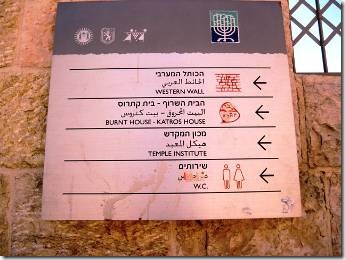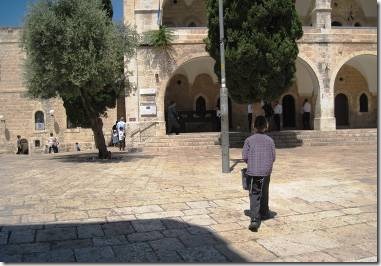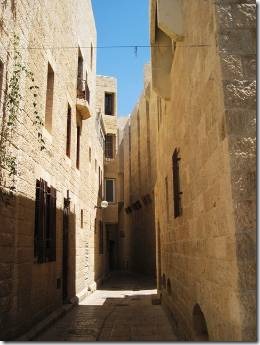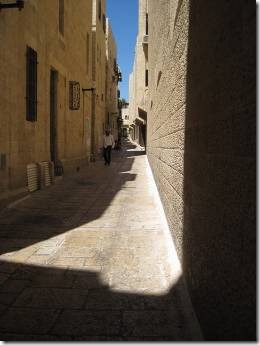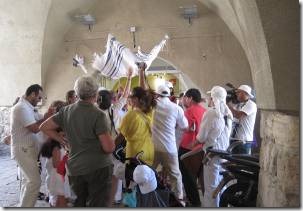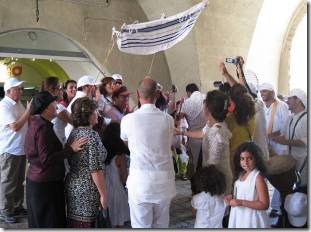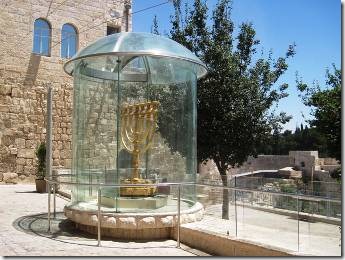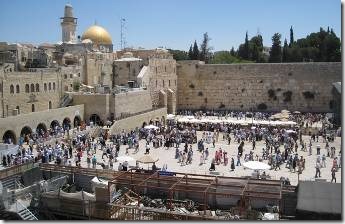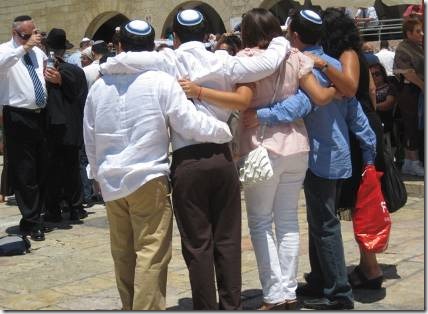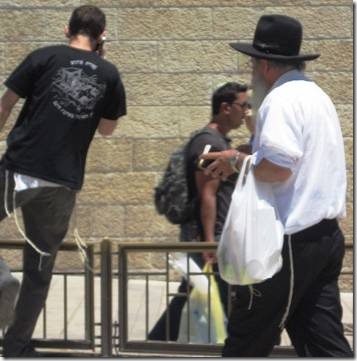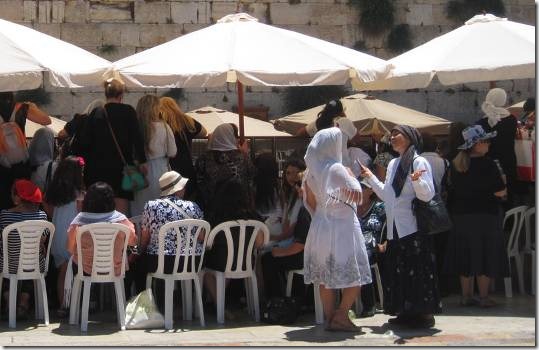Shalom
This email finishes the Ramparts Walk and takes us into the Jewish Quarter. In the email just before this I wrote about the Armenian Quarter. But I started to think that it is the quarter that’s the hardest to readily understand its existence if you don’t know much about Jerusalem. A Jewish, Christian, and Muslim section are easy to understand. Buy why Armenian?
"Tucked away in a corner of the Old City of Jerusalem lies the Armenian Patriarchate of St. James, a sprawling convent and monastery complex built on the site of Rome’s vaunted 10th Legion encampment. Like the Jews, the Armenians have survived religious persecution, attempted genocide and exile from their historic homeland, currently divided between Turkey and the U.S.S.R. Today, only 1500 Armenians remain in Jerusalem, and their future here is uncertain. According to their traditions, Armenians reached Eretz Israel between the tenth and sixth centuries BCE, when Tigranes the Great ruled an empire extending from the Caspian Sea to the shores of the Mediterranean. The first time the word "Armenia" is mentioned is in an inscription attributed to King Darius. Armenians arrived in the wake of the Roman legions, as traders, artisans, legionnaires and administrators. But it was Christianity that put the final stamp on the perpetual Armenian presence here. Diaspora Armenians are descended primarily from ancestors who lived in historic Armenia. Many still have relatives in the disparate towns and villages of Turkish Armenia, although their roots may have disappeared from the pages of history following frequent family name changes, necessitated by political exigencies. Apkar, for example, has been changed to Ali, Misak into Murad, or even Mohammed. Armenians have survived by challenging empires and by scuttling all attempts at assimilation. They believe in the eternality of their race, symbolized by their emblem – the soaring twin peaks of Mount Ararat, traditional site of Noah’s stranded ark. The goldsmiths, jewelers, photographers, pharmacists, teachers and potters who pound the ancient cobblestones of the Old City – a place that is just another diaspora for most of them – are living proof of Armenian durability." http://jcpa.org/jl/hit04.htm tells an interesting story.
So now back to the Jewish Quarter..
Ru
Israeli Security
You can never have too much security. Those are my feelings after having to even think about the Somali pirates. When Randal and I did our Ramparts Walk, just near the end, a young boy, maybe 12, passed us and then turned to follow us. He didn’t say anything or smile. He just followed us. Randal and I were alone. We didn’t know if he had friends up ahead where we couldn’t see. And this is the Middle East where things do happen. Of course, nothing happened (and two adults being wary of a young boy is sad) but the memory gave me pause about doing the other half of the walk by myself. But I was determined to go and so I went and it was fine. Actually I kept passing small groups of people on the walk so that was reassuring.
Climbing up and over the Zion Gate built in 1541
“Providing access to Mount Zion, this gate bears the marks of the Arab and Israeli battles of the 1948 War of Independence. The gate connects the Jewish and Armenian Quarters with Mount Zion, hence the name. Arabs call it “Bab Nabi Daud,” which means “Gate of the Prophet David” because legend has it that the tomb of David was located nearby, on Mount Zion.” iTravel Jerusalem
“Since the 10th century it has been thought that King David, after his 40-year reign of Israel, was probably buried here, although it is more likely that he is buried on the Ophel with the other Israelite kings.” Jerusalem
Mount of Olives
http://www.mountofolives.co.il/eng/timeline.aspx?CID=409 gives a timeline of the Mount of Olives. Click on a date for the information.
We stayed our first night in Jerusalem at the 7 Arches Hotel on Mount Olive. The next morning I was out at 6 am to walk down the mountain and through the cemetery. It was so vast that it was amazing. From Mount Olive you look over and see the Gold Dome of the Rock on Temple Mount.
http://www.mountofolives.co.il/eng/about.aspx?CID=415 shows a panorama of the area and tells its history.
“The hills of the Mount of Olives have served from time immemorial as the eastern border of ancient Jerusalem, forming a clear partition that separates the city from the edge of the Judean Desert. In fact it is a long hilly range that runs from Mount Scopus to the slopes running down to the Kidron Valley in the south, and to the foothills of the summit known as the Mount of Corruption. Its height, which is impressive in relation to its surroundings, provides a spectacular view of the city to the west and of the desert to the east.
During both the First and Second Temples Periods, the city of Jerusalem, with the Temple Mount at its centre, was the focus of Jewish life. This was to have a great influence on the status of Mount of Olives in Jewish history, tradition and culture. Its proximity to the Temple Mount, and, primarily, the view that could be had from it, gave the Mount of Olives a special religious significance and it became an integral part of the holy rites of Jerusalem. Jewish sources connect the Mount of Olives with future miraculous happenings that will occur at the time of the Redemption. These traditions turned the Mount of Olives into a place of deep Jewish significance from which developed religious practices and the Mount came to be regarded as holy and a place of pilgrimage.
The holiness of the Mount, its proximity to the city and in addition to these the texture of its rock (soft chalk, that is relatively easy to chisel out) resulted in the Mount becoming a burial place over the generations. The tradition of burial here started in the First Temple Period and has continued right down to the present day.
The Mount of Olives now offers spectacular views for tourists who come to its summit, and in addition to the impressive scenery, a variety of tours of the Mount that explore the depths of Jewish history are also available. From between its rocks the Mount softly whispers its stories and all we have to do is wander through its hidden corners to recognize its glorious past.”
Looking at ruins, and maybe and old cemetery, just outside the Old City Walls.
The walks ends just short of the Dung Gate which got its lovely name as it was thought that during the time of the 1st and 2nd Temple waste was taken out through this gate. I climbed down from the walls and wasn’t sure where I was, though I knew I was in the Jewish Quarter so I felt safe enough to wander anywhere. I also felt kind of stupid for not knowing where I was or being able to follow my map, but so it goes.
Even this didn’t help me much. But a kind woman who pointed me the “nicer way” that took me by shady lanes and a large book/Jewdaica shop where I finally bought my Jerusalem book,
Somewhere in the Batei Machase neighborhood.
Lots of this part of the Old City looked newly rebuilt since 1967 which I’ll write more about from my visit to the museum Alone on the Walls about the defense of Jerusalem in 1948.
Thursday is Bar Mitzvah day so there were lots of celebrations, for the boys. Girls are on the outside looking in as this photo on the right serendipitously captured.
Golden Menorah Jewish Quarter
The menorah (spelled this way on the website) was painstakingly crafted only after years of extensive research by the Temple Institute’s full time staff of researchers. The conclusions upon which the construction of the menora was based took into account archeological evidence and, of course, the halachic (Jewish law) requirements of materials, dimensions, ornamental affects and manner of manufacture as first delineated in the Book of Exodus, and further explicated by Jewish sages throughout the millennia.
The menora weighs one-half ton. It contains forty five kilograms of twenty four karat gold. Its estimated value is approximately three million dollars. The construction of the menora was made possible through the generosity of Vadim Rabinovitch, a leader of the Jewish community of Ukraine.
http://www.templeinstitute.org/moving-menorah.htm
http://allaboutjerusalem.com/article/golden-menorah-jerusalem
The proportions of the menorah are over two meters in height and plated with 43 kg (95 lbs) of gold.
The golden menorah is located in the Jewish Quarter in the Old City of Jerusalem. The menorah was constructed by the Temple Institute and is based on extensive research carried out by the Academic and Biblical researchers.
I walked, with about a billion other people, through the security gateway into the plaza of the Western Wall. I thought I would visit The Wall again, but it was just too crowded and I was too hot; and the awe from my first visit couldn’t be recreated. So I just looked around at the other people.
A once in a life time photo taken at someone’s Bar Mitzvah in Jerusalem at the Wall.
Three men wearing their religion in different way: notice the similar hanging fringes (Tallit Katan) on the two men and the white kippah on the man in the middle.
Tallit http://judaism.about.com/od/worshiprituals/f/tzitzit_what.htm
The mitzvah to wear Tzitzit ONLY applies to four-cornered garments. In biblical times, most clothing consisted of a four-cornered rectangle of cloth, direct from the loom, which was draped and fastened around the body. In modern times, people tend to wear more tailored clothing, which often does not consist of four corners. So a special four-cornered garment called a Tallit, which is somewhat like a shawl, is worn by those who want to fulfill the commandment to wear Tzitzit. The only religious significance of the Tallit is that it holds the Tzitzit on its corners.
According to Jewish Law, a Tallit must be long enough to be worn over the shoulders (so it qualifies as a garment). It may be made of any material, except wool and linen together (this is not a kosher combination for any clothes).
Tallit Katan (Tzitzit)
In more observant Jewish communities, boys and men often wear a Tallit Katan (little tallis). The Tallit Katan consists of a simple rectangle of cloth with a hole for the neck and fringes on the four corners. Sometimes the Tallit Katan is simply called Tzitzit.
They wear the Tallit Katan every day, all day long, under their shirts, with the Tzitzit hanging out. They do this because they want to fulfill the mitzvah of wearing Tzitzit more often than just during prayers and because it is written "and you shall see them."
So what else is new?”
The men wear the fringe and the women are on it.
All I could think of is that they come all the way to Jerusalem for the Bar Mitzvah and then can’t really even see it or be there. They have to look over the barricade that separates the men and the women.
So that’s enough for this email. But I’m not finished with Jerusalem yet, as if you ever could be. More in the next email.

